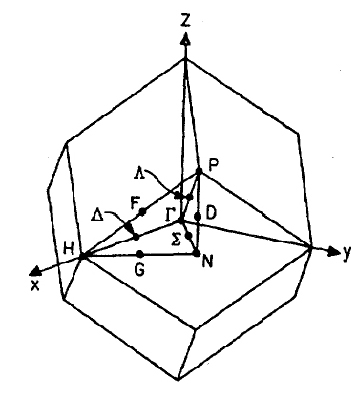Home Profile Board Links Tiếng Việt | |||||||||||||||||||||||||||||||||||||||||||||||||||||||||||||||||||||||||||||||||||||||||||||||||||||
|
1. Atomic units 2. SI units 3. DFT (Density Functional Theory) 4. N. David Mermin's speech 5. Manual guide of Pwscf package 6. Manual guide of VASP package 7. Manual guide of SIESTA package 8. Manual guide of wannier90 9. Brillouin zone 1. Atomic units
Atomic units (au) form a system of units convenient for atomic physics, electromagnetism and quantum electrodynamics.
There are two different kinds of atomic units, which one might mane Hartree atomic units and Rydberg atomic units, which differ in the choice of unit of the mass and charge. where h is Planck's constant, me and -e are the mass and the charge of electron, respectively, and ε0 is the permittivity of the free space. From these four normalized quantities, there are two more consequent nomorlized quantities, which are usually used. They are Borh radius and Hartree energy: b. Rydberg atomic units. In Rydberg atomic units, the normalization is: With this normalization, the consequent normalized quantity for lenght is still the Borh radius, but the normalized quantity for energy is Rydberg energy instead of Hartree energy: 2. SI units and conversion http://www.gordonengland.co.uk/conversion/sibase.htm The name Système International d'Unités (International System of Units)) with the international abbreviation SI is a single international language of science and technology first introduced in 1960. SI is a coherent system based on the seven independent physical quantities (base units) and derived quantities (derived units). Note that since 1995 supplementary units have been abandoned and moved into the class of derived SI units. Basic SI Units
Other physical quantities are derived from the basic units. The derived SI units are obtained by the multiplication, division, integration and differentiation of the basic units without the introduction of any numerical factors. The system of units so derived is said to be coherent. Supplementary Dimensionless SI Units
Definitions of the SI Base UnitsLength: metre (m)The metre is the length of the path travelled by light in vacuum during a time interval of 1/299 792 458 of a second.Mass: kilogram (kg)The kilogram is equal to the mass of the international prototype of the kilogram: a piece of platinum-iridium alloy kept at the International Bureau of Weights and Measures, Sévres, France.Time: second (s)The second is the duration of 9 192 631 770 periods of the radiation corresponding to the transition between the two hyperfine levels of the ground state of the cesium-133 atom.Electric current: ampere (A)The ampere is that constant current which, if maintained in two straight parallel conductors of infinite length, of negligible circular cross-section, and placed 1 metre apart in vacuum, would produce between these conductors a force equal to 2 x 10-7 newton per metre of length.Thermodynamic temperature: kelvin (K)The kelvin is 1/273.16 of the thermodynamic temperature of the triple point of water.The unit kelvin and its symbol K should be used to express both thermodynamic temperature and an interval or a difference of temperature. In addition to the thermodynamic temperature (symbol T) there is also the Celsius (symbol t) defined by the equation t=T-T0 where T0=273.15 K. Celsius temperature is expressed in degree Celsius (symbol C). The unit 'degree Celsius' is equal to the unit 'kelvin', and a temperature interval or a difference of temperature may also be expressed in degrees Celsius. (The word degree and the sign o must not be used with kelvin or K). Amount of substance: mole (mol)The mole is the amount of substance of a system which contains as many elementary entities as there are atoms in 0.012 kilogram of carbon 12.When the mole is used, the elementary entities must be specified and may be atoms, molecules, ions, electrons, other particles or specified groups of such particle. In this definition, it is understood that the carbon 12 atoms are unbound, at rest and in their ground state. Luminous intensity: candela (cd)The candela is the luminous intensity, in a given direction, of a source that emits monochromatic radiation of frequency 540 x 1012 hertz and that has a radiant intensity in that direction of 1/683 watt per steradian.Definition of Supplementary SI UnitsPlane angle: radian (rad) and solid angle: steradian (sr)The radian and steradian were classified as supplementary units. At the time of the introduction of the International System, the question of the nature of these supplementary units was left open. Considering that plane angle is generally expressed as the ratio between two lengths and solid angle as the ratio between an area and the square or a length, it was specified that in the International System the quantities plane angle and solid angle should be considered as dimensionless derived quantities. Therefore, the supplementary units radian and steradian are to be regarded as dimensionless derived units which may be used or omitted in the expressions for derived units. Since October , 1995, the class of supplementary units as a separate class in the SI has been removed. Thus the SI now consists of only two classes of units: base units and derived units, with the radian and steradian, which were the two supplementary units, moved into the class of SI derived units. 3. DFT (Density Functional Theory) DFT??? What is it? It stands for Density Functional Theory.
Question: What is the difference between theoretical physics and mathematical physics? 5. Manual guide of Pwscf package 7. Manual guide of SIESTA package 8. Manual guide of wannier90 9. Brillouin zone a. Brillouin zone of FCC
unit of k-points in cartesian coordinates is 2π/a. b. Brillouin zone of BCC
unit of k-points in cartesian coordinates is 2π/a. |
Contact email: nmcuongsphn@yahoo.com PointersSearch |
||||||||||||||||||||||||||||||||||||||||||||||||||||||||||||||||||||||||||||||||||||||||||||||||||||
 Copyrights © Copyrights © | |||||||||||||||||||||||||||||||||||||||||||||||||||||||||||||||||||||||||||||||||||||||||||||||||||||

